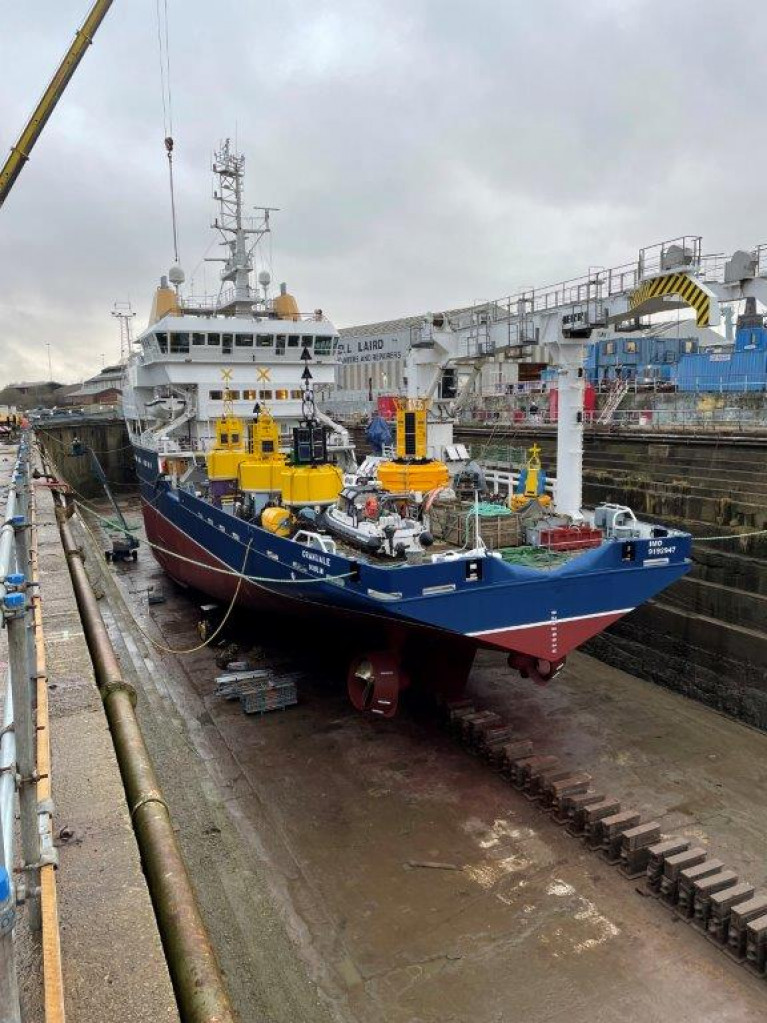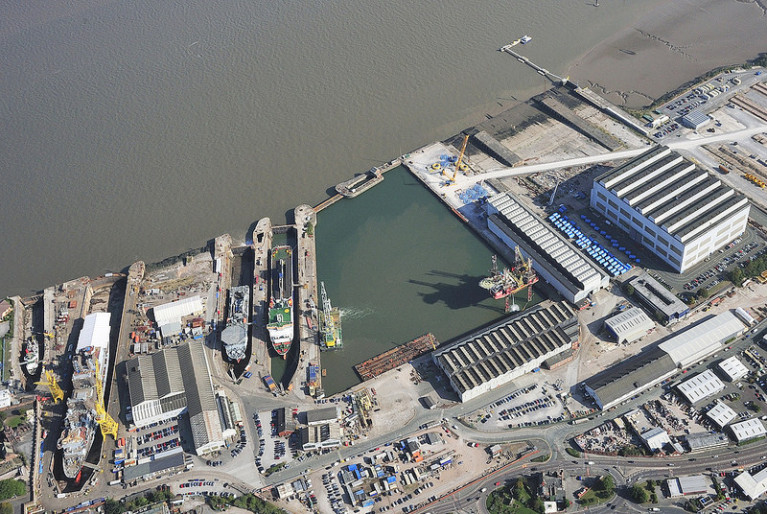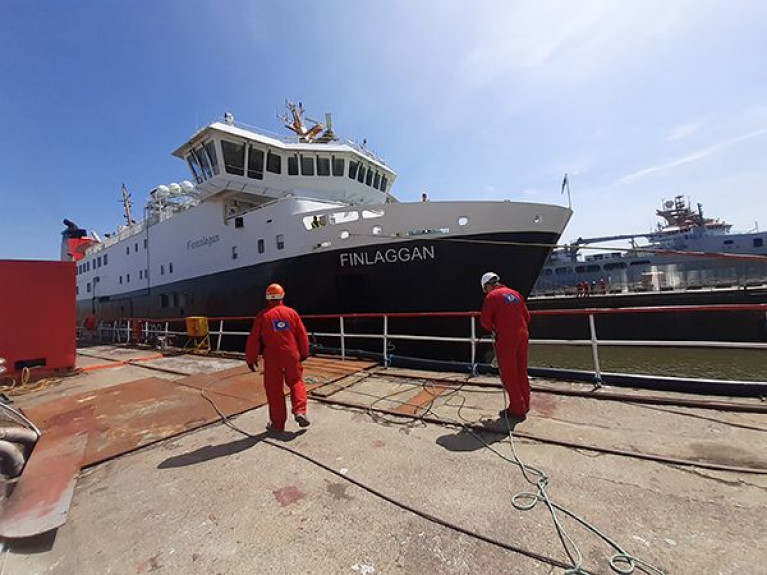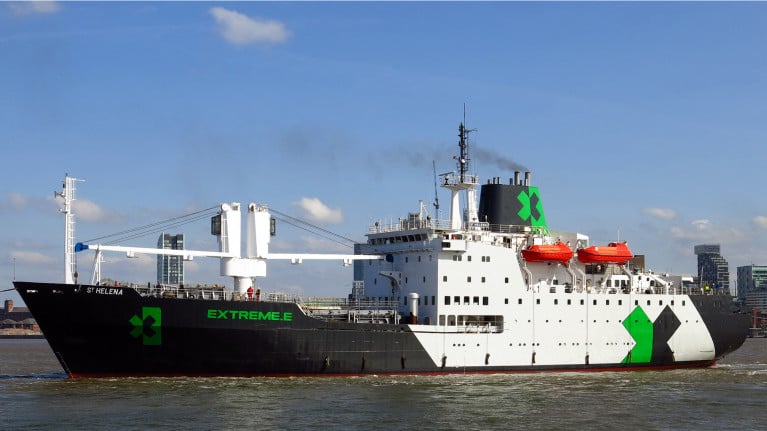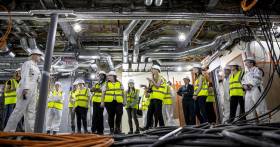Displaying items by tag: Cammell Laird
Cammell Laird Secures £2m Dolphin Contract for River Mersey Terminal
Shipbuilder and shiprepairers, Cammell Laird on Birkenhead has secured a £2m contract to build two mooring dolphins on the River Mersey for Stanlow Terminals.
Stanlow Terminals is a division of Stanlow Oil Refinery operator EET Fuels.
Cammell Laird is set to build two of these Dolphins for Stanlow Terminals and they will weigh 50 tonnes each. A mooring dolphin is a standalone structure that assists on mooring and securing a ship to a terminal or other secure structure via a rope.
In 2022, Cammell Laird successfully fabricated a single mooring dolphin for the terminal – and were subsequently asked to undertake a design study to identify opportunities to reduce fabrication time, weight and costs of the existing dolphins.
These dolphins will form a vital component of the Tranmere mooring configuration and will float at 3 metres in height (2 meters below the water level) and 7.5 meters in width.
They will provide stability for tankers during berthing, allowing them to move seamlessly with the ebb and flow of the tide.
Mike Hill, Managing Director of Cammell Laird, said: “We have developed a good relationship with Stanlow Terminals and we were delighted to have been awarded the contract to build two further dolphins.
“Cammell Laird is strategically located next to the oil terminal and our experienced workforce means we are able to deliver the best quality product for Stanlow. We look forward to working closely with the team in the months ahead.”
The commercial ship repair division of shipbuilder, Cammell Laird, Birkenhead has experienced significant growth towards the end of 2023, as business was up by 50% when compared from this time last year.
In the last two months alone, the facility on the Wirral Peninsula, welcomed more than 11 vessels for ship repair works – including new and returning customers.
Cammell Laird now operates as part of the wider APCL Group of shipbuilders and shiprepairers - (among them A&P Group) which has helped the movement of vessels across all four facilities.
In addition to the company’s recent shipbuilding contract with Mersey Ferries, Cammell Laird also undertook the Royal Iris of the Mersey's annual maintenance works which included overhaul on both rudders, pulling of both shafts, new seals and steelwork inserts on the hull.
Other vessels include returning customer Isle of Man Steam Packet Company's Manannan (see latest related story) Boskalis' Deo Gloria, Svitzer Pembroke, Boskalis Freeway (see Waterford dredging story), Svitzer Surrey, the Calmac ferry, the Lord of the Isles and the Vos Patriot.
Mike Hill, Managing Director of Cammell Laird, said: “I am delighted to see our commercial division so busy which is up 50% from this time last year.
"Over the past few months we have seen significant growth and dock utilisation across as well as having multi-ship, multi-year framework agreements in place with several customers."
"It is a fantastic end to 2023 and we look forward to welcoming further vessels in 2024."
New Mersey Ferry to Be Built Locally at Cammell Laird, Birkenhead Will be the First in 60 Years
The shipyard which built the UK's polar research ship, RRS Sir David Attenborough, Cammell Laird is to construct the first new Mersey ferry in 60 years, in a move which marks a major milestone for the shipbuilder.
Located at Birkenhead on the Wirral Peninsula, the shipyard part of the APCL group, has put pen to paper with the Liverpool City Region Combined Authority on a deal which will see the new ferry designed and built exclusively on-site (see previous related overseas shipyard story).
The state-of-the-art newbuild will be designed to harness green technology, with a cutting edge Azi-pull propeller system for reduced fuel usage, along with a diesel-electric hybrid-ready propulsion system. With this feature there is the potential for future conversion to full electric propulsion as technology evolves.
The ferry will also have an exhaust after treatment system which will operate in excess of current UK & international standards to reduce harmful nitrous oxide emissions.
It comes six decades after the last Mersey ferry, which was also built at Cammell Laird had entered service. The vessel will be designed by in-house Cammell Laird naval architects and constructed by the facility’s local workers and apprentices, with a target delivery date of the end of 2025.
The announcement today marks the culmination of a process which started back in 2016 and represents a major vote of confidence in Cammell Laird.
Ferries on the Mersey date back to the early 13th century and have become one of the most iconic modes of transport in the world. Cammell Laird has a long history with Mersey ferries, having built 15 of the vessels dating back to 1836.
The new ferry will bear the hull number 1,395 - being the 1,395th ship built at the shipyard. Other recent ferry projects have included construction of Strangford II (Afloat adds on the Ards Peninsula) Red Kestrel (Isle of Wight) Sound of Seil and Sound of Soay (Upper Clyde service).
Cammell Laird has a rich shipbuilding history dating back 200 years. Its 130-acre site has four dry docks and one of the largest modular construction halls in Europe.
Merseyside Shipyard Among UK Facilities Awarded Contracts to build Units for Royal Navy’s Type 26 Frigates
The Wirral Peninsula on the Irish Sea is where Birkenhead based shipbuilder, Cammell Laird along with North Sea based A&P Tyne have been awarded contracts by BAE Systems to build units for the UK Royal Navy’s Type 26 /City class frigates.
The advanced anti-submarine warfare vessels which Afloat reported began with the first ship, HMS Glasgow, are being constructed at BAE Systems’ sites in Govan, Scotland, but will incorporate units built from both shipyards.
A&P Tyne, a shipyard which boasts the largest fabrication facilities on the east coast of England, has built four lower units for Ship No.3, HMS Belfast, all of which were delivered earlier this year. As for the Ship No.2, Afloat highlights this is HMS Cardiff.
Cammell Laird which operates one of the largest construction halls in Europe, is building units for Ship No.4, HMS Birmingham, which will also be joining all of these units together.
The development marks the latest milestone in a hugely productive history of collaboration with BAE Systems, having previously supported the build of the Astute and Dreadnought class submarines, manufactured substantial parts of Her Majesty’s QEC Class Aircraft Carriers (see, Afloat’s Appledore Irish Naval Service story) and delivered the Type 45 Power Improvement Project (PIP).
Mike Hill, Managing Director at Cammell Laird said: “Cammell Laird has a long standing history of collaboration with BAE Systems and we are delighted to be working together to deliver the next generation of anti-submarine warfare.
“With our ability to work alongside our colleagues at A&P Tyne throughout the build process, taking the transfer of knowledge and vital experience is proving to be delivering both acceleration to the programme and significant efficiencies savings throughout.”
The Type 26 Frigates are designed for anti-submarine warfare and will replace the Type 23, with the first due to enter service later this decade.
David McGinley, Chief Executive Officer at A&P Group and Cammell Laird, said: “We have a proud track record when it comes to partnership working and delivering projects of vital national importance.
“Our commitment to the armed forces and our defence capabilities lies at the heart of our business and everything we do.”
Apprentices from both A&P and Cammell Laird have also been working on the project, a point of pride for everyone involved.
David added: “We’re fiercely and unashamedly proud to be able to play even a small role in the lives of the communities in which we’re based. And because this is the next generation of Royal Navy vessel, it’s only fitting that the next generation of our workforce should be working on it.”
Fishguard Ferry Off-Service Undergoes Repairs on Merseyside Shipyard
The Rosslare-Fishguard Stena Line ferry, which following an engine-room blaze that occurred over a week ago, is in for repairs at a shipyard on Merseyside, writes Jehan Ashmore.
Stena Europe is berthed in the Tranmere basin at the Cammell Laird shipyard in Birkenhead (which is nearby to the ferry terminal/see story).
As Afloat previously reported the crew were able to extinguish the fire which took place as the ferry was nearing the Port of Fishguard in Pemrokeshire.
All passengers and crew were unharmed having arrived to the Welsh port and from where rescue authorities were on hand to also assist as a precaution.
An investigation as to the cause of the fire is underway on the 1981 built ship which is the oldest ferry on the Irish Sea and of the Stena fleet. The Swedish owned company has a route network also on the North Sea and throughout Scandinavia.
While Stena Europe is away from the St. George's Channel route, scheduled maintenance works will also take place in Birkenhead on the ferry which arrived on Merseyside last Tuesday. This following an overnight passage from Fishguard.
According to the Stena website, sailings on the Rosslare-Fishguard route up until 26th February are suspended and all traffic (including foot passengers) will be accommodated on an alternative sailing.
This involves customers transferring to rival operator Irish Ferries on the Rosslare-Pembroke Dock route served by the chartered in Blue Star 1.
In addition Stena have facilitated those travelling with another alternative by travelling instead on their Dublin-Holyhead route.
As previously reported on Afloat, Cammell Laird, the Merseyside shipbuilder and engineering facility has been kept busy with dry-docking a range of ships among them the Commissioners of Irish Lights vessel ILV Granuaile, writes Jehan Ashmore.
The aids to navigation vessel built in 2000, mainly serves in the deployment and recovery of buoys, both inshore & offshore and is used for search and rescue missions, underwent dry-docking at the Birkenhead based facility.
Commenting to Afloat on the dry-docking, Irish Lights said, following a competitive tender process to ensure value for money, ILV Granuaile completed an Intermediate drydock in Cammell Laird during January.
As per SOLAS and Flag State requirements, all merchant vessels require a complete survey of the hull (Special drydock) every five years and an Intermediate survey mid-way in the intervening period. These dry-dockings, include maintenance of the hull, thrusters, anodes, cooling inlets and other parts which are immersed in water and normally inaccessible.
All planned work was delivered and the ship has now returned to regular duties of maintaining lighthouses, buoys and beacons around the coast of Ireland.
Afloat adds ILV Granuaile is currently working in waters off northern Donegal having departed Dun Laoghaire Harbour in recent days.
Merseyside Shipyard Cammell Laird's Busy Commercial Division Enjoys End of Financial Year
Merseyside shipyard Cammell Laird continues to enjoy a busy 2022 with a range of commercial vessels visiting its facilities for extensive programmes of works.
In the same month that Prime Minister Boris Johnson and Defence Secretary Ben Wallace visited the Birkenhead based shipyard to unveil the new National Shipbuilding Strategy Refresh, Cammell Laird completed several dry dockings and ship repair projects.
Ro-Ro passenger ship MV Hebrides departed no. 6 drydock on Wednesday, March 21 following an extensive overhaul and repair programme, which included the replacement of its sewage treatment plant, and the replacement of its fast rescue boat davits. The vessel is operated by CalMac and connects the Scottish isles of Skye and Harris.
The Stena Adventurer, a Ro-Pax ship owned by Stena Line, has returned to Cammell Laird for a large package of repair and overhaul works, which included the application of a new paint system. The ferry is one of two vessels, which operates on Stena Line’s Holyhead-Dublin route and makes two crossing per day. The ship has a maximum capacity of 1,500 passengers and 500 cars.
LM Constructor, a working barge, arrived in no. 5 drydock on Friday March 25th for five-year survey works. Built in the Netherlands in 1983, LM Constructor is a general-purpose vessel suitable for a wide range of inshore projects.
The Belgian tug Zeebrugge, is the latest vessel to depart Cammell Laird following a 16-day docking period for repair and overhaul works.
In January, Commissioners of Irish Lights vessel the ILV Granuaile docked at Cammell Laird. The multifunctional vessel, which services offshore buoys and is used for search and rescue missions, underwent general drydocking works for maintenance and repair including painting. (See CIL's Scottish counterpart vessel NLV Pharos at H&W Belfast).
Another tug, Svitzer Milgarth also docked in January for general drydock works including port and starboard aquamaster shaft seal removal, and general inspections.
The third CalMac vessel of the season, MV Clansman arrived in no.6 drydock in January also, for an extensive programme of overhaul and repair works including the removal and replacement of the sewage treatment plant and tail shaft works.
Mike Hill, Managing Director at Cammell Laird said: “It has been fantastic to see all of our ship repair facilities being used during this busy period".
“The recent works we have carried out highlights the demand of Cammell Laird and its highly skilled workforce. We look forward to welcoming our returning and new customers to the facility over the coming months.”
According to Merseyside shipyard Cammell Laird, demand for longer term repair and maintenance framework relationships from ferry operators is increasing as the sector prepares to recover from Covid.
Despite a reduction in ferry projects at the UK facility in Birkenhead, north-west England, during 2020 as many operators, particularly those involved in passenger traffic, delayed all but vital work – the market for wider maintenance and repairs is improving.
In particular, ferry operators are showing an appetite for longer term contracts and greater collaborative working with the supply chain, rather than dealing with routine repairs and maintenance on a purely annual or individual basis.
Neil Harden, Commercial Director at Cammell Laird Shiprepairers & Shipbuilders Limited said: “Although there was a reduction in ferry work during 2020 due to the pandemic, there is a growing movement away from short term thinking in favour of longer term solutions.
“Ferry operators are seeking greater certainty. That’s in relation to cost and vessel availability, but perhaps more importantly in the workings of these supplier relationships too. In our experience it is long-term collaborative partnerships that yields the in-depth knowledge of vessels that is so crucial to effective problem solving, maintaining the highest level of vessel availability and increasing programme efficiencies.”
This approach also affords Cammell Laird the opportunity to plan ahead – ensuring dock, equipment and resource availability and communicating with subcontractors well ahead of time.
In January, Cammell Laird secured a four-year contract with CalMac, one of the UK’s largest ferry operators, for the annual maintenance and dry docking of the five largest vessels in its fleet, using this model.
The contract from CalMac provides a long-term, collaborative and cost saving approach for the MV Clansman, MV Loch Seaforth, MV Lord of The Isles, MV Finlaggan and MV Hebrides. Each of the ferries will dock at Cammell Laird each year.
Neil added: “We had enjoyed a long-standing relationship with CalMac Ferries for some time, but this is the first time we’ve been awarded a long-term framework type contract in this way.
“Since the start of this year, interest in this long term contractual model has really piqued and we are currently exploring a number of similar agreements with several major UK ferry operators. We have the optimum facilities to support the ferry sector with four docks to suit larger vessels, plus the afloat berthing facility in the wet basin is used for MCA life raft deployments and running engines under load after major overhauls.”
During 2020, Cammell Laird delivered projects also for CalMac's MV Finlaggan (as pictured) for rudder repairs. In addition Seatruck Ferries’ ro ro freight ferry mv Arrow following grounding damage, and another of ro ro freighter MV Clipper Point, that was in dry-dock for bow thruster repairs.
In the first quarter of 2021 Cammell Laird undertook seven scheduled ferry dry dockings. Another 13 routine repair and maintenance dry dockings are scheduled for later this year.
The Irish Sea shipyard of Cammell Laird in the UK at Birkenhead on Merseyside has reported a strong 2020 despite the challenges of Covid-19 – with its construction hall, workshops and dry docks in continuous use since the start of the year.
Speaking about operating during a global pandemic, the CEO of Cammell Laird, David McGinley said: “Despite the restrictions and challenges of the last few months, the needs of our clients have not changed, and we have seen consistent demand for our engineering expertise and on-site facilities.
“The team has shown fortitude, commitment and agility throughout, which has been instrumental in keeping clients’ vessels operational and maintaining our reputation for engineering excellence.”
Projects of note during 2020 have included achieving a series of important milestones in the construction of RRS Sir David Attenborough – the research ship that will transform how ship-borne science is carried out in the Polar Regions.
Cammell Laird has tested and commissioned the vessel’s lifeboats and power systems and most recently, the water mist fire protection system. Work is now focused on readying the vessel for sea trials in October, which includes commissioning and testing the marine propulsion systems as well as checking the vessel’s scientific underwater sensors and deployment mechanisms.
Other notable projects include the ongoing transformation of unique cargo-passenger ship RMS St Helena (see Irish call) and later London, as she becomes a mobile hub for the Extreme Electric SUV racing series.
Cammell Laird is also preparing for the start of the next ferry season, which will see the return of all four Calmac Ferries (CalMac) for their annual maintenance periods.
Focusing on Cammell Laird’s roster of defence work, the yard has welcomed the first of the UK's Royal Navy’s Type 45 class of destroyer to Birkenhead.
Dauntless is undergoing her Power Improvement Programme (PIP), which will improve the resilience of the power and propulsion systems by replacing two diesel generators with three new systems and modifying the high voltage system.
In addition Afloat adds contracts for the RFA'S Tide class replenishment tankers that entered service for the UK's Royal Fleet Auxiliary from 2017. These ships provide in the provision of fuel, food, fresh water, ammunition and other supplies to RN vessels around the world.
In the UK shipyard of marine engineering services company Cammell Laird based in Birkenhead, young women had a behind-the-scenes glimpse of life in engineering as part of International Women in Engineering Day (INWED) 2019.
Ten girls from schools and colleges in Birkenhead and surrounding areas met female engineers and saw shipbuilding in progress during the event organised by the shipyard and the Engineering College.
The event aimed to encourage more women into engineering and highlight the opportunities available as Cammell Laird prepares to launch a recruitment drive for apprentices.
The girls even toured polar research vessel the Sir David Attenborough, described to them by Cammell Laird chief operating officer Tony Graham as “the ship that will save the planet”. And they heard first-hand how the build is progressing from Carrie Harris, second engineer with the British Antarctic Survey, who will be one of eight women out of the ship’s 28 crew once it launches.
Mr Graham addressed the group of young women with Cammell Laird managing director Paul Owen to explain why the day was so important.
He said: “Just increasing our workforce numbers isn’t good enough for me. We need increasing levels of diversity and the right kind of talent in the business, people with passion and loyalty, who are confident and willing to learn, who are going to go on our growth journey with us.
“I’ve always considered engineering to be the only true discipline that leaves people with life defining memories and there isn’t anybody working on the Sir David Attenborough now who won’t still be talking about it in ten years’ time. We create national monuments and we need to inspire the next generation of young women to get excited about engineering.”
Mr Owen said engineering had given him the opportunity to visit 130 countries during his career. “If you are driven by challenges then engineering is a great environment to be in, but don’t wait for other people to give you these opportunities,” he said.
The day began with a visit to the neighbouring Engineering College, where Cammell Laird apprentices train, where Olivia Weston, a degree apprentice in the marketing department and a mentor for The Girls’ Network, talked about how engineering can cover all walks of life. “We’ve trained engineers who go on to fix machinery in intensive care departments, work in heavy industry or provide the audio-visual equipment in a George Ezra concert – engineering really is in everything you can think of,” she said.
The group then moved over to Cammell Laird where the girls heard from assistant ship manager Claire Biggar and former mechanical fitting apprentice Kirsten Blood, who is now a quality inspector in the tooling department.
Kirsten told the group: “The shipyard is fast-paced and ever-changing and there’s always a huge sense of achievement in everything we do. It can be a bit disheartening that there aren’t more female chief engineers or captains of ships, so we want to see more girls coming through the yard.”
Claire, a former Royal Navy weapons engineer, is currently overseeing the painting of the Sir David Attenborough.
“Ship building, and engineering, amazes me every day and it can be whatever you want it to be and take you wherever you want to go,” she said.
Carrie Harris, who led a tour of the Sir David Attenborough, will oversee the running of the vessel, which she told the group could involve everything from whether the radar was working to whether the toilets were flushing.
She said: “If you’re looking at an apprenticeship there’s a lot of job stability in engineering. It was by accident that I got into engineering but there’s nothing else I’d rather be doing.”
The International Women in Engineering Day (INWED) event aims to encourage more women into engineering careers and was backed by businesses and organisations across the industry.


























